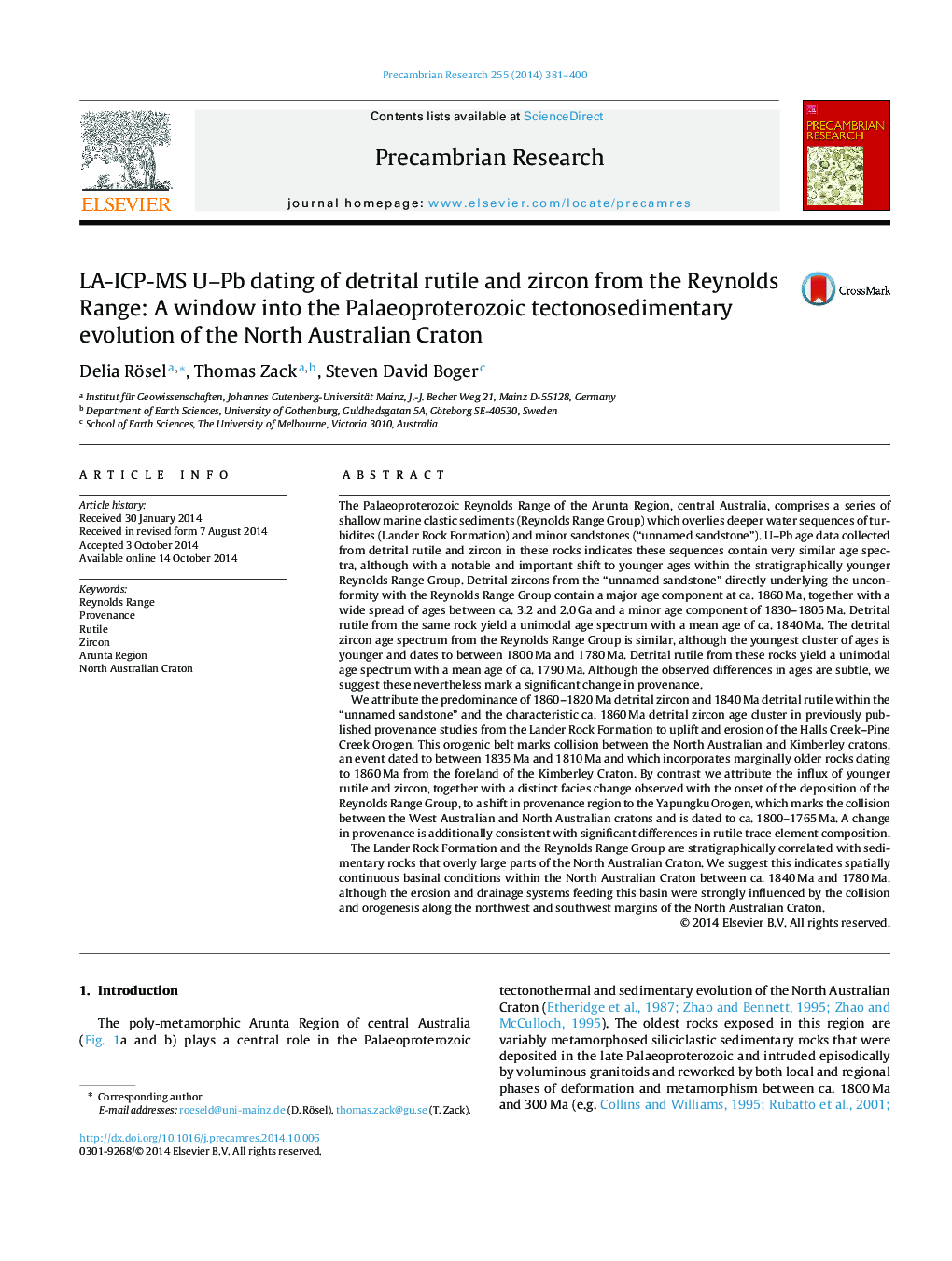| کد مقاله | کد نشریه | سال انتشار | مقاله انگلیسی | نسخه تمام متن |
|---|---|---|---|---|
| 4722795 | 1355488 | 2014 | 20 صفحه PDF | دانلود رایگان |

• First provenance study of detrital rutile in Palaeoproterozoic sediments.
• Combined U–Pb age study of detrital rutile and zircon from the Reynolds Range.
• Shift in provenance region at ca. 1800 Ma.
• Lander Package was sourced from the Halls Creek–Pine Creek Orogen.
• Younger Reynolds Range Group was sourced from the Yapungku Orogen.
The Palaeoproterozoic Reynolds Range of the Arunta Region, central Australia, comprises a series of shallow marine clastic sediments (Reynolds Range Group) which overlies deeper water sequences of turbidites (Lander Rock Formation) and minor sandstones (“unnamed sandstone”). U–Pb age data collected from detrital rutile and zircon in these rocks indicates these sequences contain very similar age spectra, although with a notable and important shift to younger ages within the stratigraphically younger Reynolds Range Group. Detrital zircons from the “unnamed sandstone” directly underlying the unconformity with the Reynolds Range Group contain a major age component at ca. 1860 Ma, together with a wide spread of ages between ca. 3.2 and 2.0 Ga and a minor age component of 1830–1805 Ma. Detrital rutile from the same rock yield a unimodal age spectrum with a mean age of ca. 1840 Ma. The detrital zircon age spectrum from the Reynolds Range Group is similar, although the youngest cluster of ages is younger and dates to between 1800 Ma and 1780 Ma. Detrital rutile from these rocks yield a unimodal age spectrum with a mean age of ca. 1790 Ma. Although the observed differences in ages are subtle, we suggest these nevertheless mark a significant change in provenance.We attribute the predominance of 1860–1820 Ma detrital zircon and 1840 Ma detrital rutile within the “unnamed sandstone” and the characteristic ca. 1860 Ma detrital zircon age cluster in previously published provenance studies from the Lander Rock Formation to uplift and erosion of the Halls Creek–Pine Creek Orogen. This orogenic belt marks collision between the North Australian and Kimberley cratons, an event dated to between 1835 Ma and 1810 Ma and which incorporates marginally older rocks dating to 1860 Ma from the foreland of the Kimberley Craton. By contrast we attribute the influx of younger rutile and zircon, together with a distinct facies change observed with the onset of the deposition of the Reynolds Range Group, to a shift in provenance region to the Yapungku Orogen, which marks the collision between the West Australian and North Australian cratons and is dated to ca. 1800–1765 Ma. A change in provenance is additionally consistent with significant differences in rutile trace element composition.The Lander Rock Formation and the Reynolds Range Group are stratigraphically correlated with sedimentary rocks that overly large parts of the North Australian Craton. We suggest this indicates spatially continuous basinal conditions within the North Australian Craton between ca. 1840 Ma and 1780 Ma, although the erosion and drainage systems feeding this basin were strongly influenced by the collision and orogenesis along the northwest and southwest margins of the North Australian Craton.
Journal: Precambrian Research - Volume 255, Part 1, December 2014, Pages 381–400